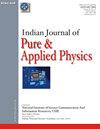印度哈里亚纳邦Gurugram土壤样品中氡和钍的呼出率估计
IF 1.1
4区 物理与天体物理
Q4 PHYSICS, MULTIDISCIPLINARY
引用次数: 0
摘要
自然放射性是指由于铀、钍、钾等基本放射性核素在土壤、岩石和水中持续存在的放射性。因此,辐射影响着地球上的每个人。由于放射性核素对人类健康的有害影响,全世界的研究人员都觉得这个问题特别有趣。为了客观地评价环境中的这些放射性核素,有必要采用可靠的方法进行系统的调查。本文利用基于ZnS:Ag闪烁体的SMART RnDuo(印度AQTEK系统)测量了土壤样品中222Rn和220Rn同位素(氡和钍)的呼出率。对40个土壤样品进行了研究。对于222Rn的研究,进行了大量呼出(Rm)的监测。在220Rn的情况下,研究了表面呼出(Rs)的监测。氡质量呼出率范围为14±1 ~ 55±5 mBqkg−1h−1,平均值为34±10 mBqkg−1h−1;氡表面呼出率范围为2200±215 ~ 7560±420 Bqm−2h−1,平均值为4280±960 Bqm−2h−1。因此,在大多数样品中观察到钍水平升高。结果与世界平均值进行了比较。本文章由计算机程序翻译,如有差异,请以英文原文为准。
Estimation of Exhalation Rates of Radon and Thoron in the Soil Samples Collected from Gurugram, Haryana, India
Natural radioactivity is the term used to describe radioactivity that persists in the soil, rocks, and water due to fundamental radionuclides such as uranium, thorium, potassium, etc. As a result, radiation affects everyone on the planet. Researchers worldwide find this topic particularly interesting due to the hazardous effects of radionuclides on human health. A systematic survey employing trustworthy methodological approaches is necessary to objectively assess these radionuclides in the environment. In the present paper, ZnS:Ag scintillator-based SMART RnDuo (AQTEK System, India) is used to measure exhalation rates of isotopes 222Rn and 220Rn (radon and thoron) of soil samples. Forty soil samples were studied. For the study of 222Rn, monitoring of the mass exhalation (Rm) was conducted. In the case of 220Rn, monitoring of surface exhalation (Rs) was studied. The radon mass exhalation rate is found in the range of 14±1 to 55±5 mBqkg−1h−1 with an average of 34±10 mBqkg−1h−1 and thoron surface exhalation rate in the range of 2200±215 to 7560±420 Bqm−2h−1 with an average of 4280±960 Bqm−2h−1. Thus, elevated thoron level is observed in most of the samples. Results are compared with the world’s average values.
求助全文
通过发布文献求助,成功后即可免费获取论文全文。
去求助
来源期刊
CiteScore
1.30
自引率
14.30%
发文量
42
审稿时长
7 months
期刊介绍:
Started in 1963, this journal publishes Original Research Contribution as full papers, notes and reviews on classical and quantum physics, relativity and gravitation; statistical physics and thermodynamics; specific instrumentation and techniques of general use in physics, elementary particles and fields, nuclear physics, atomic and molecular physics, fundamental area of phenomenology, optics, acoustics and fluid dynamics, plasmas and electric discharges, condensed matter-structural, mechanical and thermal properties, electronic, structure, electrical, magnetic and optical properties, cross-disciplinary physics and related areas of science and technology, geophysics, astrophysics and astronomy. It also includes latest findings in the subject under News Scan.

 求助内容:
求助内容: 应助结果提醒方式:
应助结果提醒方式:


